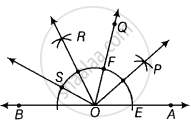Advertisements
Advertisements
प्रश्न
Draw an angle of 80° with the help of a protractor. Then construct angles of (i) 40° (ii) 160° and (iii) 120°.
उत्तर
First, draw an angle of 80° say ∠QOA = 180° with the help of protractor.
Now, use the following steps to construct angles of (i) 40° (ii) 160° (iii) 120°

1. Taking O as centre and any radius draw an arc which intersect OA at E and OO at F.
2. Taking E and F as centres and radius more than `1/2` EF draw arcs which intersect each other at P.
3. Join OP. Thus, ∠POA = 40° ...`[∴ 40^circ = 1/2 xx 80^circ]`
4. Now, taking F as centre and radius equal to EF draw an arc which intersect previous arc obtained in step ii at S.
5. Join OS. Thus, ∠SOA = 160° ...[∴ 160° = 2 × 80°]
6. Taking S and F as centre and radius more than `1/2` SF draw arcs which intersect each other at R.
7. Join OR. Thus, ∠ROA = ∠ROQ = 40° + 80° = 120°.
APPEARS IN
संबंधित प्रश्न
Construct an angle of 90° at the initial point of a given ray and justify the construction.
Construct the angles of the following measurement:- `22 1/2^@`
Construct an equilateral triangle, given its side and justify the construction.
Draw a line segment AB of length 5.8 cm. Draw the perpendicular bisector of this line
segment.
Using a protractor, draw an angle of measure 72°. With this angle as given, draw angles of measure 36° and 54°.
Construct the following angles at the initial point of a given ray and justify the construction 90°.
Construct the angle of the measurement:
1 . 75°
Construct the angle of the measurement:
1. 15°
Draw an angle of 110° with the help of a protractor and bisect it. Measure each angle.
Draw a line segment AB of 4 cm in length. Draw a line perpendicular to AB through A and B, respectively. Are these lines parallel?
